Comprehensive Audit and Assurance Report: DIPL Ltd Financials
VerifiedAdded on 2020/03/01
|8
|1999
|478
Report
AI Summary
This report presents an audit and assurance analysis of DIPL Ltd's financial statements. It begins with an overview of analytical procedures, including the calculation and interpretation of key financial ratios such as gross profit ratio, current ratio, quick ratio, debt-to-equity ratio, and interest coverage ratio, highlighting trends and potential concerns. The report then delves into risk assessment procedures, identifying inherent risks related to the recording of cash payments and control over inventory, emphasizing the potential for errors, omissions, and manipulation. Finally, the report examines fraud risk factors within DIPL Ltd, focusing on the adoption of a new IT system and unusual heavy expenditures, and explaining how these factors can create opportunities and incentives for fraudulent activities. The analysis incorporates relevant references to support the findings.

AUDIT AND ASSURANCE
Paraphrase This Document
Need a fresh take? Get an instant paraphrase of this document with our AI Paraphraser
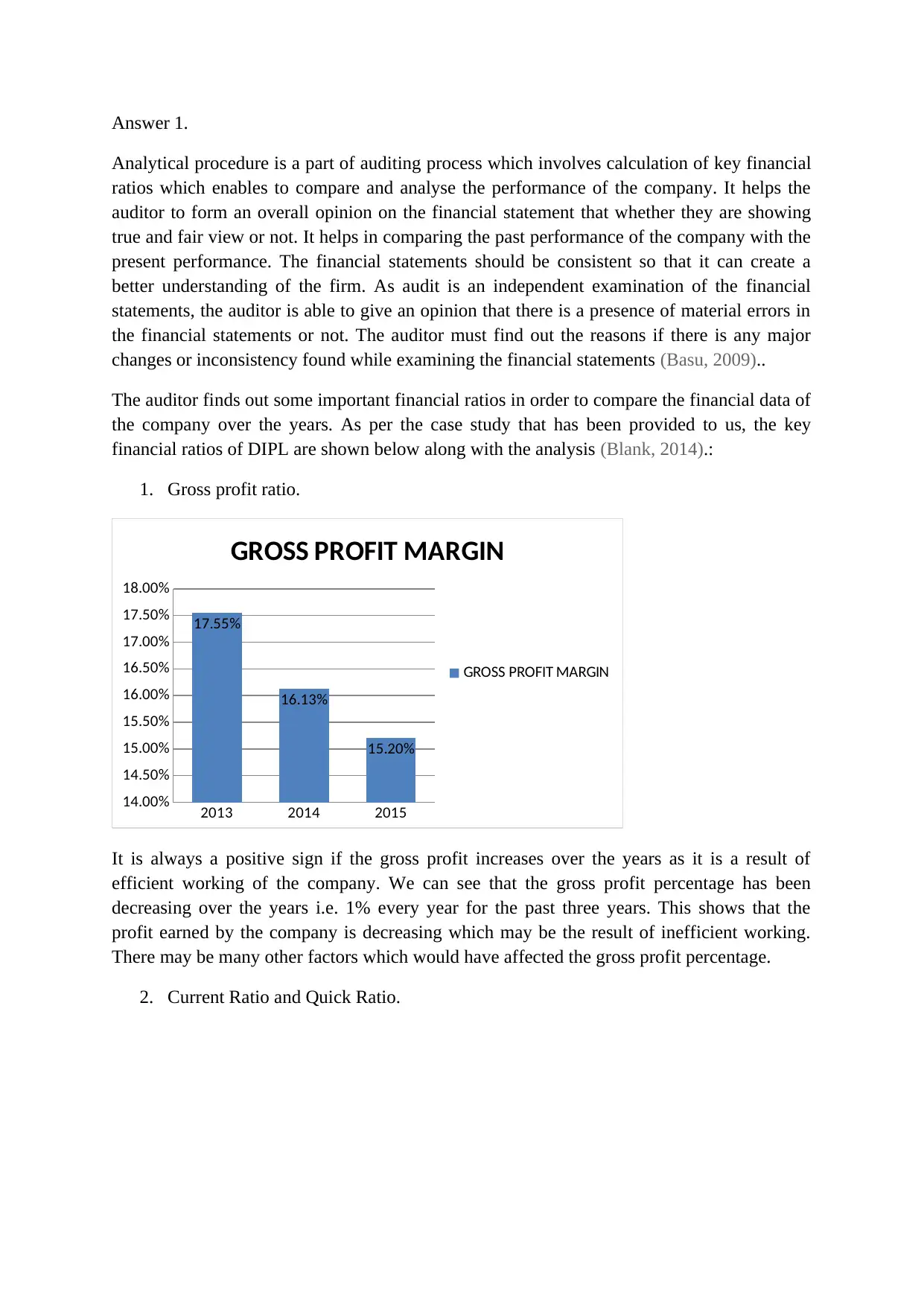
Answer 1.
Analytical procedure is a part of auditing process which involves calculation of key financial
ratios which enables to compare and analyse the performance of the company. It helps the
auditor to form an overall opinion on the financial statement that whether they are showing
true and fair view or not. It helps in comparing the past performance of the company with the
present performance. The financial statements should be consistent so that it can create a
better understanding of the firm. As audit is an independent examination of the financial
statements, the auditor is able to give an opinion that there is a presence of material errors in
the financial statements or not. The auditor must find out the reasons if there is any major
changes or inconsistency found while examining the financial statements (Basu, 2009)..
The auditor finds out some important financial ratios in order to compare the financial data of
the company over the years. As per the case study that has been provided to us, the key
financial ratios of DIPL are shown below along with the analysis (Blank, 2014).:
1. Gross profit ratio.
2013 2014 2015
14.00%
14.50%
15.00%
15.50%
16.00%
16.50%
17.00%
17.50%
18.00%
17.55%
16.13%
15.20%
GROSS PROFIT MARGIN
GROSS PROFIT MARGIN
It is always a positive sign if the gross profit increases over the years as it is a result of
efficient working of the company. We can see that the gross profit percentage has been
decreasing over the years i.e. 1% every year for the past three years. This shows that the
profit earned by the company is decreasing which may be the result of inefficient working.
There may be many other factors which would have affected the gross profit percentage.
2. Current Ratio and Quick Ratio.
Analytical procedure is a part of auditing process which involves calculation of key financial
ratios which enables to compare and analyse the performance of the company. It helps the
auditor to form an overall opinion on the financial statement that whether they are showing
true and fair view or not. It helps in comparing the past performance of the company with the
present performance. The financial statements should be consistent so that it can create a
better understanding of the firm. As audit is an independent examination of the financial
statements, the auditor is able to give an opinion that there is a presence of material errors in
the financial statements or not. The auditor must find out the reasons if there is any major
changes or inconsistency found while examining the financial statements (Basu, 2009)..
The auditor finds out some important financial ratios in order to compare the financial data of
the company over the years. As per the case study that has been provided to us, the key
financial ratios of DIPL are shown below along with the analysis (Blank, 2014).:
1. Gross profit ratio.
2013 2014 2015
14.00%
14.50%
15.00%
15.50%
16.00%
16.50%
17.00%
17.50%
18.00%
17.55%
16.13%
15.20%
GROSS PROFIT MARGIN
GROSS PROFIT MARGIN
It is always a positive sign if the gross profit increases over the years as it is a result of
efficient working of the company. We can see that the gross profit percentage has been
decreasing over the years i.e. 1% every year for the past three years. This shows that the
profit earned by the company is decreasing which may be the result of inefficient working.
There may be many other factors which would have affected the gross profit percentage.
2. Current Ratio and Quick Ratio.
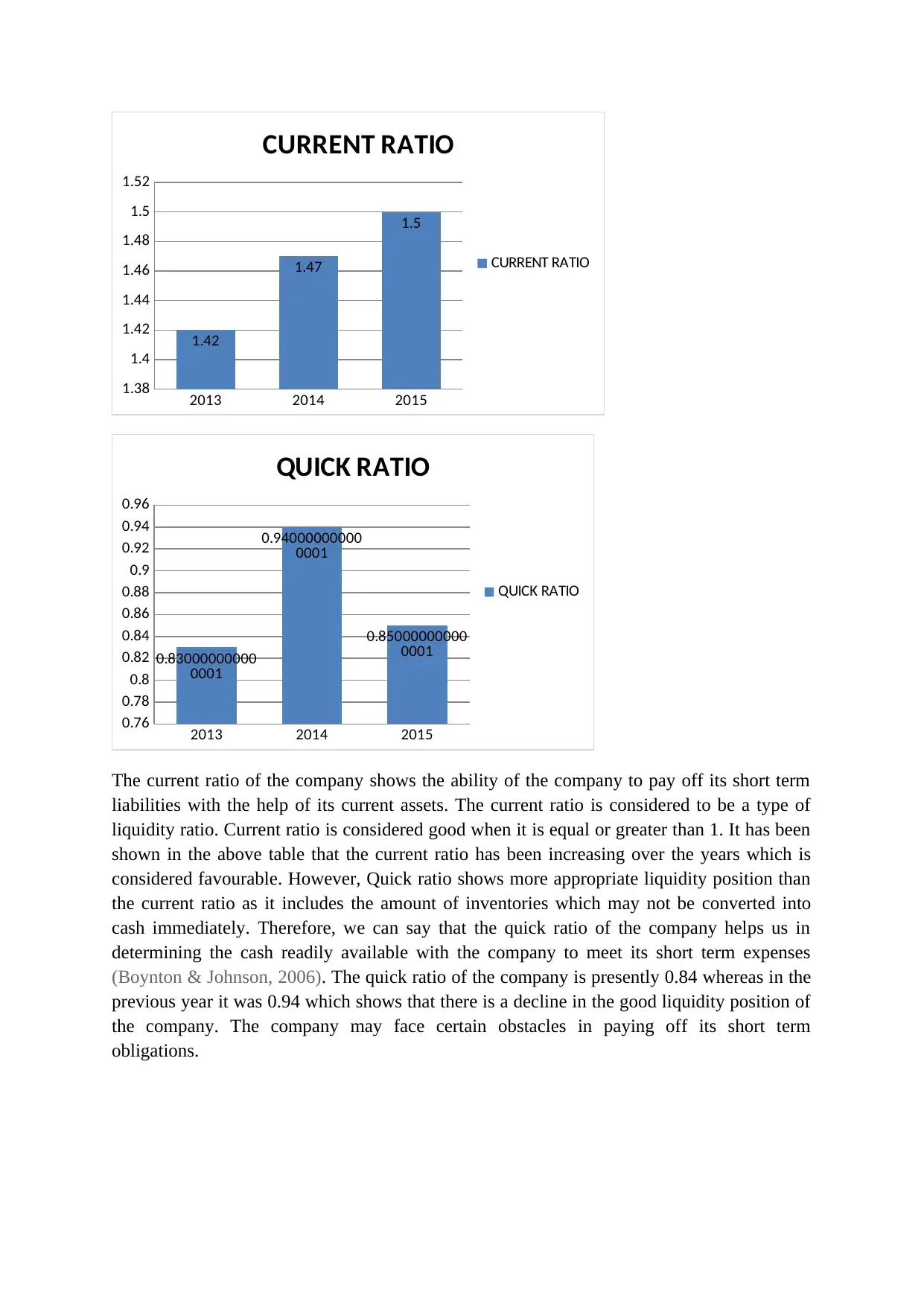
2013 2014 2015
1.38
1.4
1.42
1.44
1.46
1.48
1.5
1.52
1.42
1.47
1.5
CURRENT RATIO
CURRENT RATIO
2013 2014 2015
0.76
0.78
0.8
0.82
0.84
0.86
0.88
0.9
0.92
0.94
0.96
0.83000000000
0001
0.94000000000
0001
0.85000000000
0001
QUICK RATIO
QUICK RATIO
The current ratio of the company shows the ability of the company to pay off its short term
liabilities with the help of its current assets. The current ratio is considered to be a type of
liquidity ratio. Current ratio is considered good when it is equal or greater than 1. It has been
shown in the above table that the current ratio has been increasing over the years which is
considered favourable. However, Quick ratio shows more appropriate liquidity position than
the current ratio as it includes the amount of inventories which may not be converted into
cash immediately. Therefore, we can say that the quick ratio of the company helps us in
determining the cash readily available with the company to meet its short term expenses
(Boynton & Johnson, 2006). The quick ratio of the company is presently 0.84 whereas in the
previous year it was 0.94 which shows that there is a decline in the good liquidity position of
the company. The company may face certain obstacles in paying off its short term
obligations.
1.38
1.4
1.42
1.44
1.46
1.48
1.5
1.52
1.42
1.47
1.5
CURRENT RATIO
CURRENT RATIO
2013 2014 2015
0.76
0.78
0.8
0.82
0.84
0.86
0.88
0.9
0.92
0.94
0.96
0.83000000000
0001
0.94000000000
0001
0.85000000000
0001
QUICK RATIO
QUICK RATIO
The current ratio of the company shows the ability of the company to pay off its short term
liabilities with the help of its current assets. The current ratio is considered to be a type of
liquidity ratio. Current ratio is considered good when it is equal or greater than 1. It has been
shown in the above table that the current ratio has been increasing over the years which is
considered favourable. However, Quick ratio shows more appropriate liquidity position than
the current ratio as it includes the amount of inventories which may not be converted into
cash immediately. Therefore, we can say that the quick ratio of the company helps us in
determining the cash readily available with the company to meet its short term expenses
(Boynton & Johnson, 2006). The quick ratio of the company is presently 0.84 whereas in the
previous year it was 0.94 which shows that there is a decline in the good liquidity position of
the company. The company may face certain obstacles in paying off its short term
obligations.
⊘ This is a preview!⊘
Do you want full access?
Subscribe today to unlock all pages.

Trusted by 1+ million students worldwide
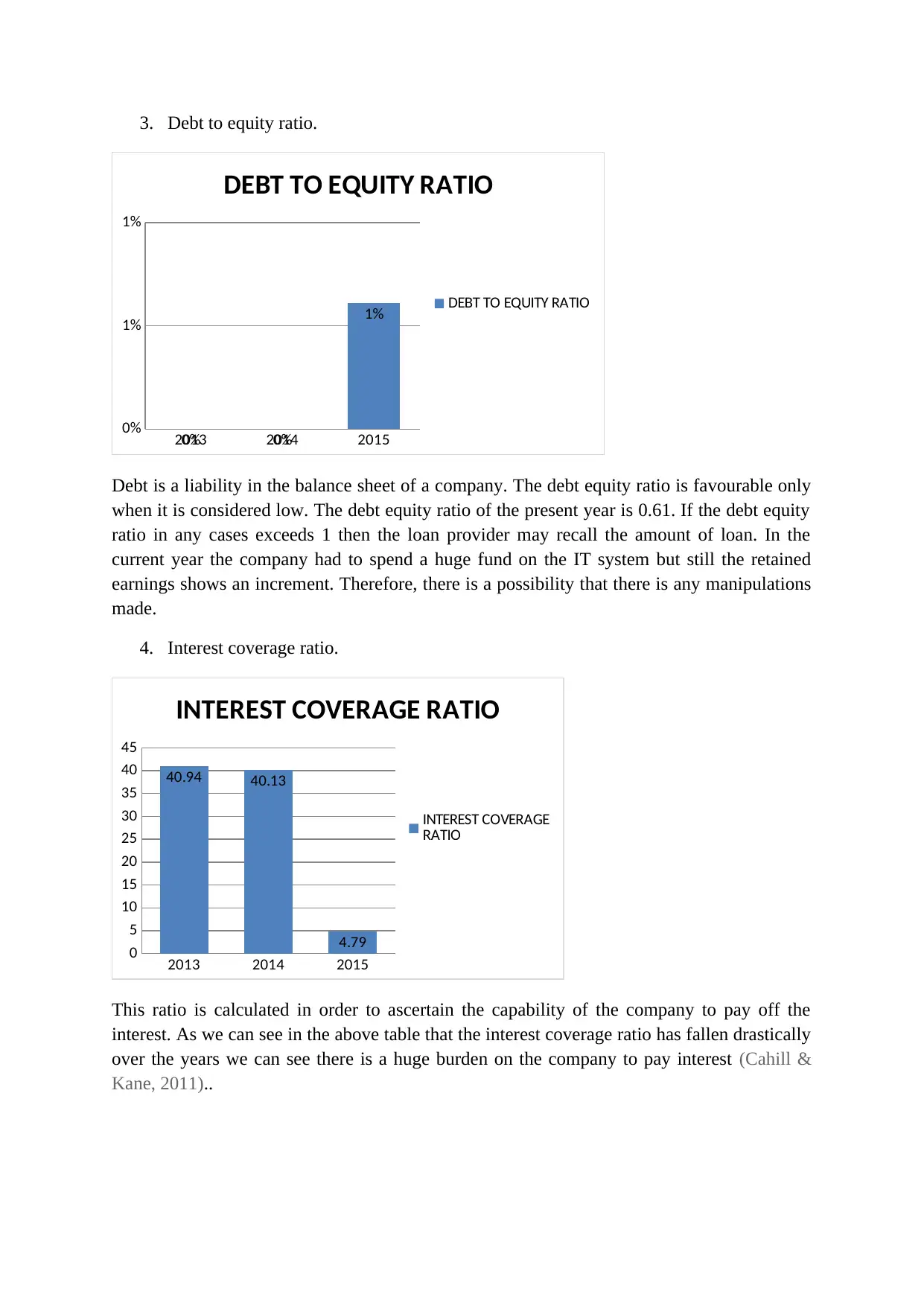
3. Debt to equity ratio.
2013 2014 2015
0%
1%
1%
0% 0%
1%
DEBT TO EQUITY RATIO
DEBT TO EQUITY RATIO
Debt is a liability in the balance sheet of a company. The debt equity ratio is favourable only
when it is considered low. The debt equity ratio of the present year is 0.61. If the debt equity
ratio in any cases exceeds 1 then the loan provider may recall the amount of loan. In the
current year the company had to spend a huge fund on the IT system but still the retained
earnings shows an increment. Therefore, there is a possibility that there is any manipulations
made.
4. Interest coverage ratio.
2013 2014 2015
0
5
10
15
20
25
30
35
40
45
40.94 40.13
4.79
INTEREST COVERAGE RATIO
INTEREST COVERAGE
RATIO
This ratio is calculated in order to ascertain the capability of the company to pay off the
interest. As we can see in the above table that the interest coverage ratio has fallen drastically
over the years we can see there is a huge burden on the company to pay interest (Cahill &
Kane, 2011)..
2013 2014 2015
0%
1%
1%
0% 0%
1%
DEBT TO EQUITY RATIO
DEBT TO EQUITY RATIO
Debt is a liability in the balance sheet of a company. The debt equity ratio is favourable only
when it is considered low. The debt equity ratio of the present year is 0.61. If the debt equity
ratio in any cases exceeds 1 then the loan provider may recall the amount of loan. In the
current year the company had to spend a huge fund on the IT system but still the retained
earnings shows an increment. Therefore, there is a possibility that there is any manipulations
made.
4. Interest coverage ratio.
2013 2014 2015
0
5
10
15
20
25
30
35
40
45
40.94 40.13
4.79
INTEREST COVERAGE RATIO
INTEREST COVERAGE
RATIO
This ratio is calculated in order to ascertain the capability of the company to pay off the
interest. As we can see in the above table that the interest coverage ratio has fallen drastically
over the years we can see there is a huge burden on the company to pay interest (Cahill &
Kane, 2011)..
Paraphrase This Document
Need a fresh take? Get an instant paraphrase of this document with our AI Paraphraser
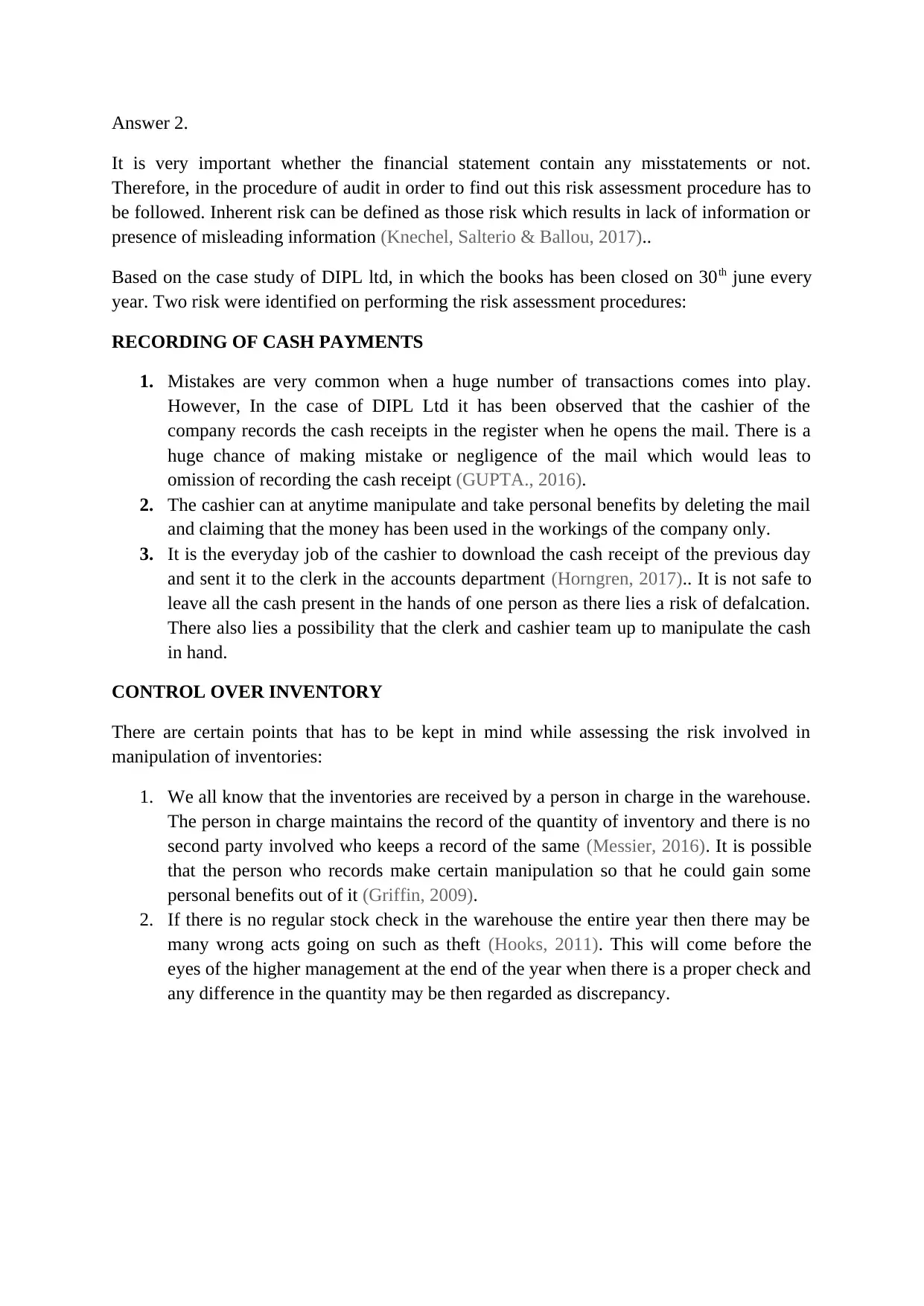
Answer 2.
It is very important whether the financial statement contain any misstatements or not.
Therefore, in the procedure of audit in order to find out this risk assessment procedure has to
be followed. Inherent risk can be defined as those risk which results in lack of information or
presence of misleading information (Knechel, Salterio & Ballou, 2017)..
Based on the case study of DIPL ltd, in which the books has been closed on 30th june every
year. Two risk were identified on performing the risk assessment procedures:
RECORDING OF CASH PAYMENTS
1. Mistakes are very common when a huge number of transactions comes into play.
However, In the case of DIPL Ltd it has been observed that the cashier of the
company records the cash receipts in the register when he opens the mail. There is a
huge chance of making mistake or negligence of the mail which would leas to
omission of recording the cash receipt (GUPTA., 2016).
2. The cashier can at anytime manipulate and take personal benefits by deleting the mail
and claiming that the money has been used in the workings of the company only.
3. It is the everyday job of the cashier to download the cash receipt of the previous day
and sent it to the clerk in the accounts department (Horngren, 2017).. It is not safe to
leave all the cash present in the hands of one person as there lies a risk of defalcation.
There also lies a possibility that the clerk and cashier team up to manipulate the cash
in hand.
CONTROL OVER INVENTORY
There are certain points that has to be kept in mind while assessing the risk involved in
manipulation of inventories:
1. We all know that the inventories are received by a person in charge in the warehouse.
The person in charge maintains the record of the quantity of inventory and there is no
second party involved who keeps a record of the same (Messier, 2016). It is possible
that the person who records make certain manipulation so that he could gain some
personal benefits out of it (Griffin, 2009).
2. If there is no regular stock check in the warehouse the entire year then there may be
many wrong acts going on such as theft (Hooks, 2011). This will come before the
eyes of the higher management at the end of the year when there is a proper check and
any difference in the quantity may be then regarded as discrepancy.
It is very important whether the financial statement contain any misstatements or not.
Therefore, in the procedure of audit in order to find out this risk assessment procedure has to
be followed. Inherent risk can be defined as those risk which results in lack of information or
presence of misleading information (Knechel, Salterio & Ballou, 2017)..
Based on the case study of DIPL ltd, in which the books has been closed on 30th june every
year. Two risk were identified on performing the risk assessment procedures:
RECORDING OF CASH PAYMENTS
1. Mistakes are very common when a huge number of transactions comes into play.
However, In the case of DIPL Ltd it has been observed that the cashier of the
company records the cash receipts in the register when he opens the mail. There is a
huge chance of making mistake or negligence of the mail which would leas to
omission of recording the cash receipt (GUPTA., 2016).
2. The cashier can at anytime manipulate and take personal benefits by deleting the mail
and claiming that the money has been used in the workings of the company only.
3. It is the everyday job of the cashier to download the cash receipt of the previous day
and sent it to the clerk in the accounts department (Horngren, 2017).. It is not safe to
leave all the cash present in the hands of one person as there lies a risk of defalcation.
There also lies a possibility that the clerk and cashier team up to manipulate the cash
in hand.
CONTROL OVER INVENTORY
There are certain points that has to be kept in mind while assessing the risk involved in
manipulation of inventories:
1. We all know that the inventories are received by a person in charge in the warehouse.
The person in charge maintains the record of the quantity of inventory and there is no
second party involved who keeps a record of the same (Messier, 2016). It is possible
that the person who records make certain manipulation so that he could gain some
personal benefits out of it (Griffin, 2009).
2. If there is no regular stock check in the warehouse the entire year then there may be
many wrong acts going on such as theft (Hooks, 2011). This will come before the
eyes of the higher management at the end of the year when there is a proper check and
any difference in the quantity may be then regarded as discrepancy.
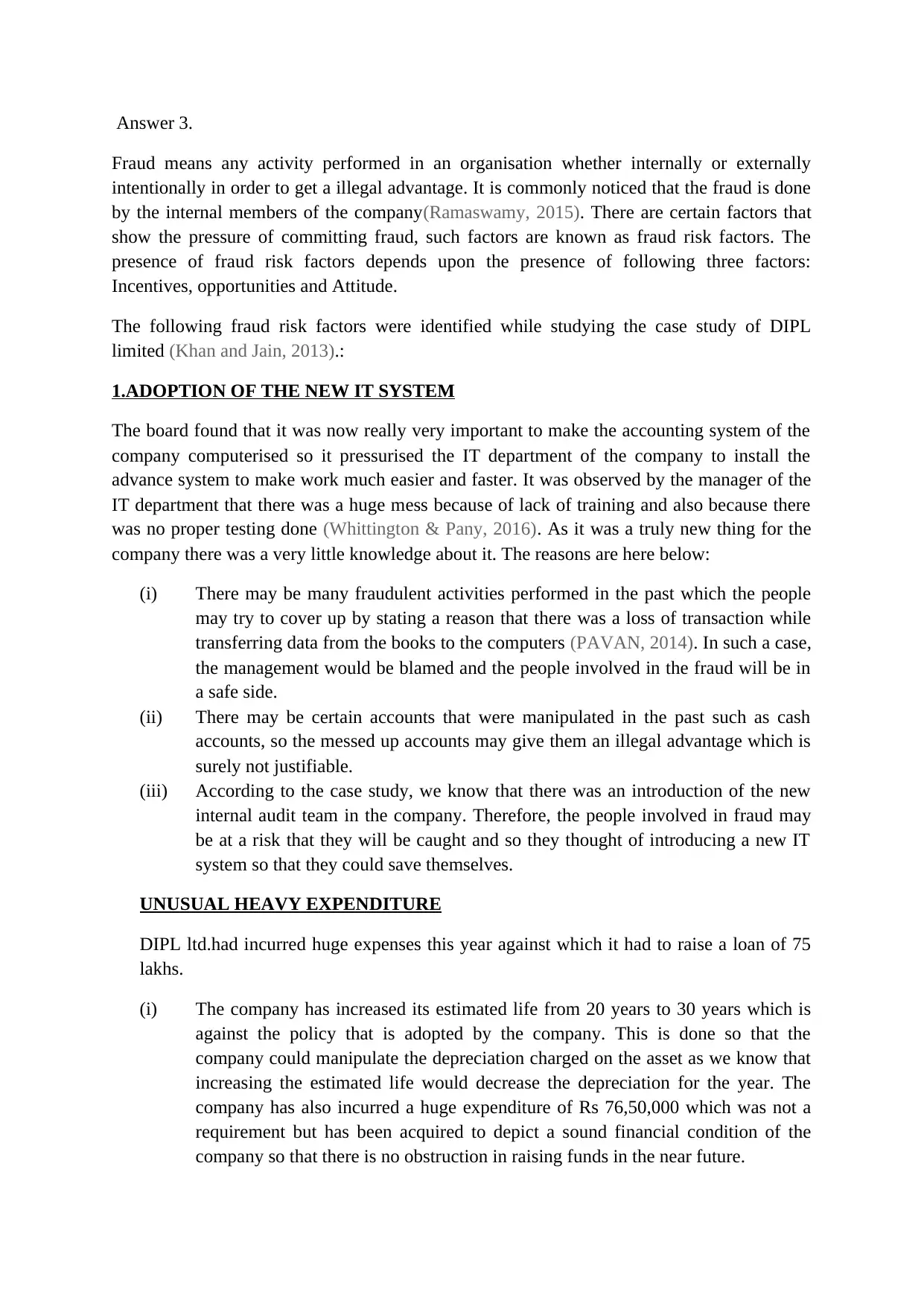
Answer 3.
Fraud means any activity performed in an organisation whether internally or externally
intentionally in order to get a illegal advantage. It is commonly noticed that the fraud is done
by the internal members of the company(Ramaswamy, 2015). There are certain factors that
show the pressure of committing fraud, such factors are known as fraud risk factors. The
presence of fraud risk factors depends upon the presence of following three factors:
Incentives, opportunities and Attitude.
The following fraud risk factors were identified while studying the case study of DIPL
limited (Khan and Jain, 2013).:
1.ADOPTION OF THE NEW IT SYSTEM
The board found that it was now really very important to make the accounting system of the
company computerised so it pressurised the IT department of the company to install the
advance system to make work much easier and faster. It was observed by the manager of the
IT department that there was a huge mess because of lack of training and also because there
was no proper testing done (Whittington & Pany, 2016). As it was a truly new thing for the
company there was a very little knowledge about it. The reasons are here below:
(i) There may be many fraudulent activities performed in the past which the people
may try to cover up by stating a reason that there was a loss of transaction while
transferring data from the books to the computers (PAVAN, 2014). In such a case,
the management would be blamed and the people involved in the fraud will be in
a safe side.
(ii) There may be certain accounts that were manipulated in the past such as cash
accounts, so the messed up accounts may give them an illegal advantage which is
surely not justifiable.
(iii) According to the case study, we know that there was an introduction of the new
internal audit team in the company. Therefore, the people involved in fraud may
be at a risk that they will be caught and so they thought of introducing a new IT
system so that they could save themselves.
UNUSUAL HEAVY EXPENDITURE
DIPL ltd.had incurred huge expenses this year against which it had to raise a loan of 75
lakhs.
(i) The company has increased its estimated life from 20 years to 30 years which is
against the policy that is adopted by the company. This is done so that the
company could manipulate the depreciation charged on the asset as we know that
increasing the estimated life would decrease the depreciation for the year. The
company has also incurred a huge expenditure of Rs 76,50,000 which was not a
requirement but has been acquired to depict a sound financial condition of the
company so that there is no obstruction in raising funds in the near future.
Fraud means any activity performed in an organisation whether internally or externally
intentionally in order to get a illegal advantage. It is commonly noticed that the fraud is done
by the internal members of the company(Ramaswamy, 2015). There are certain factors that
show the pressure of committing fraud, such factors are known as fraud risk factors. The
presence of fraud risk factors depends upon the presence of following three factors:
Incentives, opportunities and Attitude.
The following fraud risk factors were identified while studying the case study of DIPL
limited (Khan and Jain, 2013).:
1.ADOPTION OF THE NEW IT SYSTEM
The board found that it was now really very important to make the accounting system of the
company computerised so it pressurised the IT department of the company to install the
advance system to make work much easier and faster. It was observed by the manager of the
IT department that there was a huge mess because of lack of training and also because there
was no proper testing done (Whittington & Pany, 2016). As it was a truly new thing for the
company there was a very little knowledge about it. The reasons are here below:
(i) There may be many fraudulent activities performed in the past which the people
may try to cover up by stating a reason that there was a loss of transaction while
transferring data from the books to the computers (PAVAN, 2014). In such a case,
the management would be blamed and the people involved in the fraud will be in
a safe side.
(ii) There may be certain accounts that were manipulated in the past such as cash
accounts, so the messed up accounts may give them an illegal advantage which is
surely not justifiable.
(iii) According to the case study, we know that there was an introduction of the new
internal audit team in the company. Therefore, the people involved in fraud may
be at a risk that they will be caught and so they thought of introducing a new IT
system so that they could save themselves.
UNUSUAL HEAVY EXPENDITURE
DIPL ltd.had incurred huge expenses this year against which it had to raise a loan of 75
lakhs.
(i) The company has increased its estimated life from 20 years to 30 years which is
against the policy that is adopted by the company. This is done so that the
company could manipulate the depreciation charged on the asset as we know that
increasing the estimated life would decrease the depreciation for the year. The
company has also incurred a huge expenditure of Rs 76,50,000 which was not a
requirement but has been acquired to depict a sound financial condition of the
company so that there is no obstruction in raising funds in the near future.
⊘ This is a preview!⊘
Do you want full access?
Subscribe today to unlock all pages.

Trusted by 1+ million students worldwide
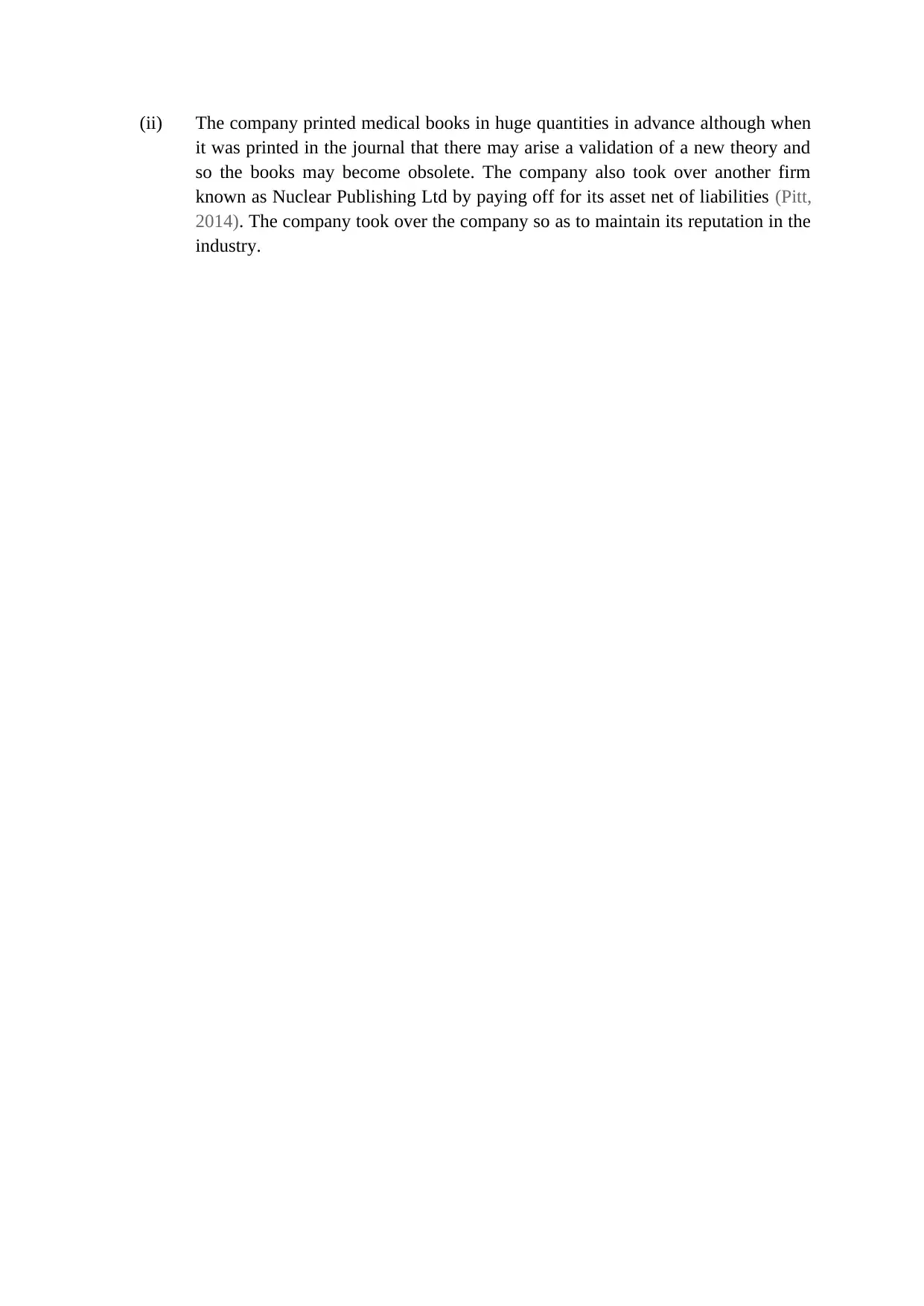
(ii) The company printed medical books in huge quantities in advance although when
it was printed in the journal that there may arise a validation of a new theory and
so the books may become obsolete. The company also took over another firm
known as Nuclear Publishing Ltd by paying off for its asset net of liabilities (Pitt,
2014). The company took over the company so as to maintain its reputation in the
industry.
it was printed in the journal that there may arise a validation of a new theory and
so the books may become obsolete. The company also took over another firm
known as Nuclear Publishing Ltd by paying off for its asset net of liabilities (Pitt,
2014). The company took over the company so as to maintain its reputation in the
industry.
Paraphrase This Document
Need a fresh take? Get an instant paraphrase of this document with our AI Paraphraser
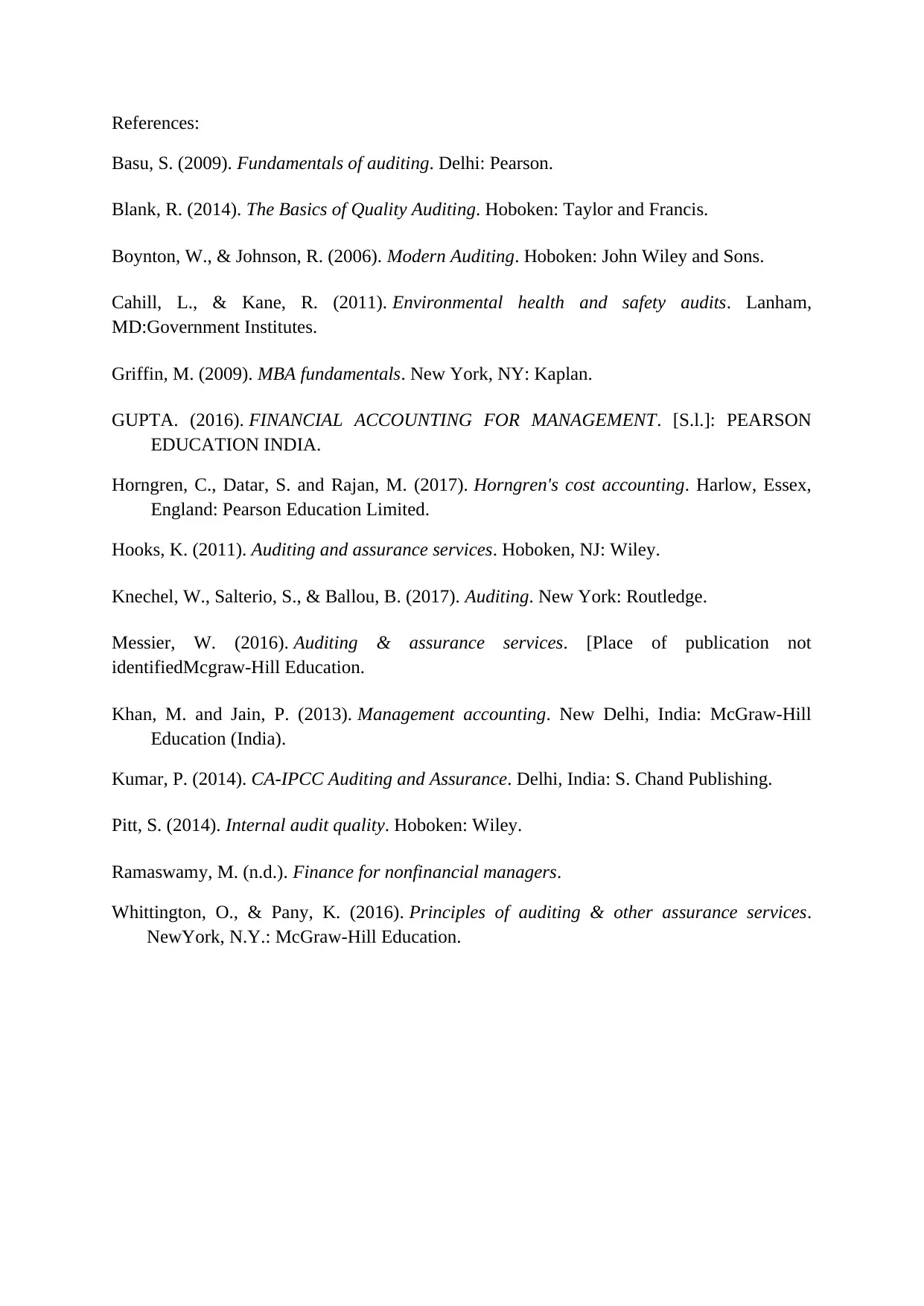
References:
Basu, S. (2009). Fundamentals of auditing. Delhi: Pearson.
Blank, R. (2014). The Basics of Quality Auditing. Hoboken: Taylor and Francis.
Boynton, W., & Johnson, R. (2006). Modern Auditing. Hoboken: John Wiley and Sons.
Cahill, L., & Kane, R. (2011). Environmental health and safety audits. Lanham,
MD:Government Institutes.
Griffin, M. (2009). MBA fundamentals. New York, NY: Kaplan.
GUPTA. (2016). FINANCIAL ACCOUNTING FOR MANAGEMENT. [S.l.]: PEARSON
EDUCATION INDIA.
Horngren, C., Datar, S. and Rajan, M. (2017). Horngren's cost accounting. Harlow, Essex,
England: Pearson Education Limited.
Hooks, K. (2011). Auditing and assurance services. Hoboken, NJ: Wiley.
Knechel, W., Salterio, S., & Ballou, B. (2017). Auditing. New York: Routledge.
Messier, W. (2016). Auditing & assurance services. [Place of publication not
identifiedMcgraw-Hill Education.
Khan, M. and Jain, P. (2013). Management accounting. New Delhi, India: McGraw-Hill
Education (India).
Kumar, P. (2014). CA-IPCC Auditing and Assurance. Delhi, India: S. Chand Publishing.
Pitt, S. (2014). Internal audit quality. Hoboken: Wiley.
Ramaswamy, M. (n.d.). Finance for nonfinancial managers.
Whittington, O., & Pany, K. (2016). Principles of auditing & other assurance services.
NewYork, N.Y.: McGraw-Hill Education.
Basu, S. (2009). Fundamentals of auditing. Delhi: Pearson.
Blank, R. (2014). The Basics of Quality Auditing. Hoboken: Taylor and Francis.
Boynton, W., & Johnson, R. (2006). Modern Auditing. Hoboken: John Wiley and Sons.
Cahill, L., & Kane, R. (2011). Environmental health and safety audits. Lanham,
MD:Government Institutes.
Griffin, M. (2009). MBA fundamentals. New York, NY: Kaplan.
GUPTA. (2016). FINANCIAL ACCOUNTING FOR MANAGEMENT. [S.l.]: PEARSON
EDUCATION INDIA.
Horngren, C., Datar, S. and Rajan, M. (2017). Horngren's cost accounting. Harlow, Essex,
England: Pearson Education Limited.
Hooks, K. (2011). Auditing and assurance services. Hoboken, NJ: Wiley.
Knechel, W., Salterio, S., & Ballou, B. (2017). Auditing. New York: Routledge.
Messier, W. (2016). Auditing & assurance services. [Place of publication not
identifiedMcgraw-Hill Education.
Khan, M. and Jain, P. (2013). Management accounting. New Delhi, India: McGraw-Hill
Education (India).
Kumar, P. (2014). CA-IPCC Auditing and Assurance. Delhi, India: S. Chand Publishing.
Pitt, S. (2014). Internal audit quality. Hoboken: Wiley.
Ramaswamy, M. (n.d.). Finance for nonfinancial managers.
Whittington, O., & Pany, K. (2016). Principles of auditing & other assurance services.
NewYork, N.Y.: McGraw-Hill Education.
1 out of 8
Related Documents
Your All-in-One AI-Powered Toolkit for Academic Success.
+13062052269
info@desklib.com
Available 24*7 on WhatsApp / Email
![[object Object]](/_next/static/media/star-bottom.7253800d.svg)
Unlock your academic potential
Copyright © 2020–2025 A2Z Services. All Rights Reserved. Developed and managed by ZUCOL.





